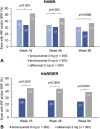A CONSENSUS ON RISK MITIGATION FOR BROLUCIZUMAB IN NEOVASCULAR AGE-RELATED MACULAR DEGENERATION: Patient Selection, Evaluation, and Treatment
- PMID: 35994582
- PMCID: PMC9387760
- DOI: 10.1097/IAE.0000000000003556
A CONSENSUS ON RISK MITIGATION FOR BROLUCIZUMAB IN NEOVASCULAR AGE-RELATED MACULAR DEGENERATION: Patient Selection, Evaluation, and Treatment
Abstract
Purpose: Brolucizumab has high efficacy in retinal fluid resolution and provides the possibility for longer dosing intervals in the treatment of neovascular age-related macular degeneration. However, brolucizumab has been associated with events of retinal vasculitis and retinal vascular occlusion typically in the presence of other signs of intraocular inflammation (IOI). The purpose of this report is to provide guidance on the use of brolucizumab for neovascular age-related macular degeneration to a global audience.
Methods: A literature review was conducted on adverse events related to IOI after administration of brolucizumab in eyes with neovascular age-related macular degeneration.
Results: Possible risk factors for IOI and retinal vascular occlusion after brolucizumab should be considered before administering brolucizumab. Patients who receive brolucizumab should be educated on the symptoms, signs, and time course of IOI after brolucizumab. Before each injection of brolucizumab, physicians should assess the eye for any signs of inflammation and not treat with brolucizumab if inflammation is detected. Treatment of IOI should be prompt and provided with particular attention to the posterior segment.
Conclusion: Careful patient selection, patient education, assessment for inflammation, and intensive treatment of possible inflammation are important when using brolucizumab in patients with neovascular age-related macular degeneration.
Copyright © 2022 The Author(s). Published by Wolters Kluwer Health, Inc. on behalf of the Opthalmic Communications Society, Inc.
Conflict of interest statement
None of the authors has any financial/conflicting interests to disclose.
Figures


References
-
- Boulanger-Scemama E, Querques G, About F, et al. Ranibizumab for exudative age-related macular degeneration: a five year study of adherence to follow-up in a real-life setting. J Fr Ophtalmol 2015;38:620–627. - PubMed
-
- MacCumber MW. Real-world injection intervals in wet AMD. Retina Today May/June 2020 Special Report.
Publication types
MeSH terms
Substances
LinkOut - more resources
Full Text Sources
Medical
Miscellaneous

